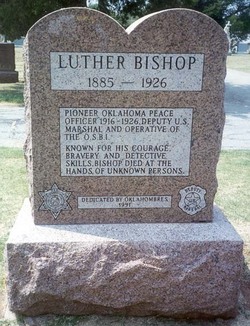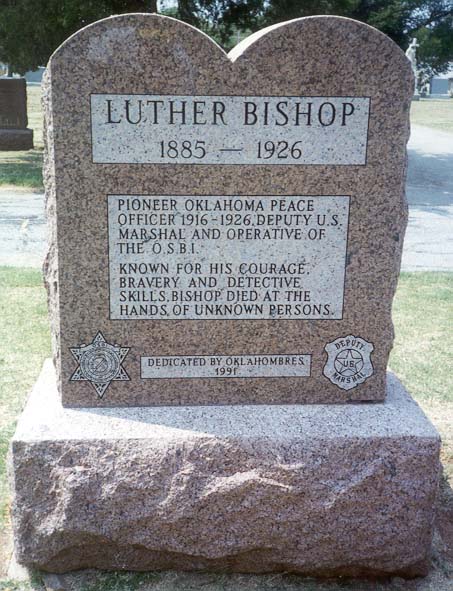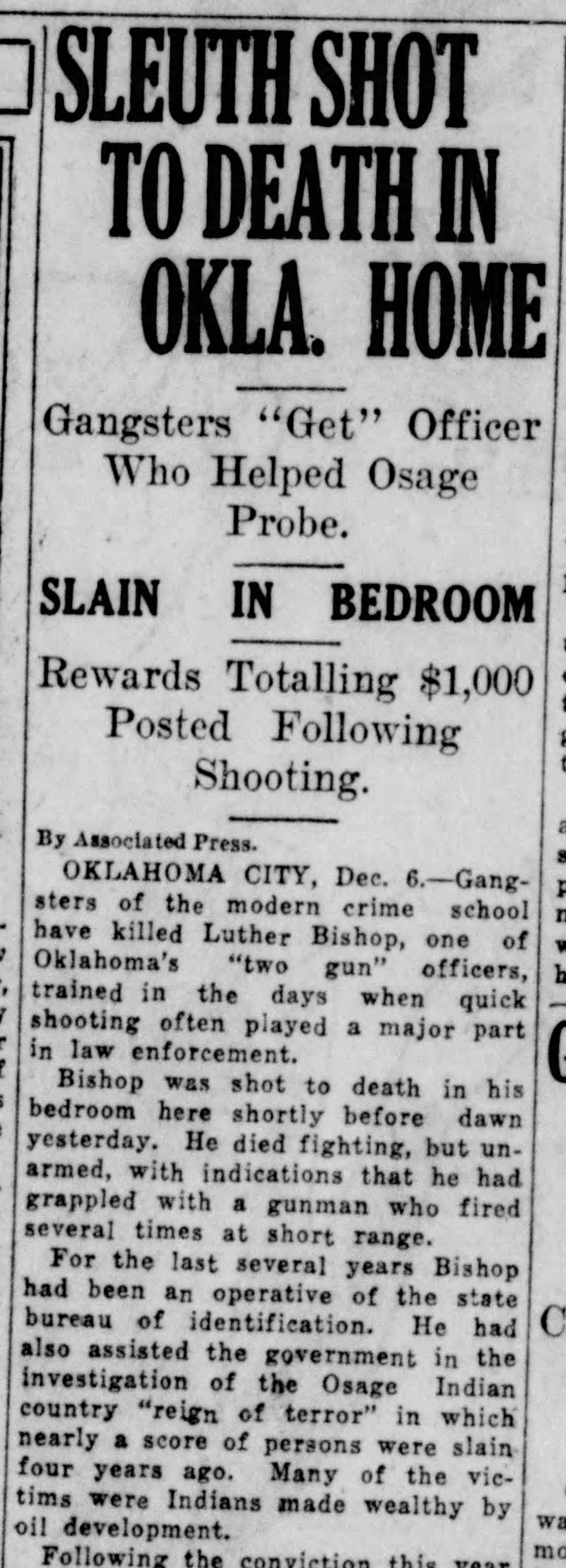12/6/1926 In Memoriam (Monday)
Luther Bishop, 41 years old, died early Sunday morning at his home, 1515 W. 28th street as a result of gunshot wounds. He is survived by his wife, Mrs. Edith Bishop, a son, Leo Bishop, three brothers, Austin Bishop of Clarksville, Texas, Lonnie Bishop of Arden, N.C., and William Bishop; two sisters, Mrs. Charles L. Harris of Tulsa and Mrs. Hy Lydia of Arden, N.C., and his father, S.B. Bishop of Arden, N.C. Arrangements will be announced later by the Hahn funeral home.
12/9/1926 In Memoriam (Thursday)
Funeral services for Luther Bishop, 41 yeas old, who died early Sunday morning as a result of gunshot wounds, will be conducted at the First Christian church Thursday afternoon at 2 o'clock by Rev. H.E. Van Horn. Burial will be in Fairlawn cemetery under direction of the Hahn funeral home. (THE OKLAHOMAN)
Agent Bishop was described by a federal agent as having "been successful in putting in the penitentiary more bank robbers and other outlaws than any other man in this state." Bishop was also given credit for helping solve the "Reign of Terror of the Osage Hills" murder case in which Osage Indians were murdered for their oil money. In order to solve the case, Bishop "borrowed" convicted bank robber Blackie Thompson from the state penitentiary to use as an informant - an innovative technique for the times. Luther Bishop was murdered by an unknown assassin. The operative of the State Bureau was riddled with bullets as he slept. Mrs. Edith Bishop, widow of Luther Bishop, was arrested for his murder. She was acquitted of the crime after a jury trial. The Bishop murder case has never been solved. [Contributed by George Bacon]
Probably the most controversial case of (William E.) Snelson's short tenure (as chief of the Oklahoma City Police Department) was the murder of State Crime Bureau Agent Luther Bishop. Although only 41 years old, Bishop had already carved out a legendary reputation in Oklahoma law enforcement. He had served as a Deputy Sheriff in Caddo and Oklahoma counties, the jailer for Oklahoma county and the town marshal for Britton, a small suburb north of the city that was eventually annexed. He had also been on the OCPD before becoming an agent for the State Crime Bureau. Earlier in the year, he had been instrumental in solving the murders in the Osage Hills Reign of Terror in the northern part of the state. He had most recently been working in Sapulpa guarding members of the Kimes gang prior to their bank robbery trials. Bishop returned from Sapulpa on the evening of Saturday, December 4, 1926, to his home at 1515 N. W. 28th in OKC. Shortly after 2AM the following morning, his neighbors were awakened by a series of gunshots. As Bishop's son and neighbors ran upstairs to the second story bedroom Bishop shared with his wife, they found him dead on the floor, shot seven times. The evidence indicated that Bishop had been shot while he slept. Two of the shots were in his back, three hit him in the left arm, one in his right arm and one in his chest. Four of the shots had pierced his lungs. Chief Snelson said powder burns indicated that Bishop was shot at close range. Bishop had a reputation as being a very aggressive officer. He always carried 2 .44 pistols and kept them close to his bedside. They were missing on initial investigation. The slugs that killed Bishop were .44s but most were badly damaged. The initial report called it a "well planned execution" saying the killer(s) hid in the house until everyone was asleep. 2 bedroom windows were open and the screens were unlatched. Governor Trapp offered a $500 reward and a donor added another $500. Inconsistencies started right away; did neighbors hear or not hear cars departing after the shots; were the Bishops having domestic problems?; After being shot why did he attempt to go to light switch bypassing his .44s location?; Mrs. Bishop was arrested and jailed the next day; 36 hours later they found the 2 .44s under some clothes in an upstairs bedroom, (both had been fired a total of 8 times); Chief Snelson fired a department chief for insubordination, because he argued they should have completed a search of the home immediately to look for the guns; Mrs. Bishop was released the next day after a coroner's jury decreed that the murder was done by a "person or persons unknown". Luther Bishop was buried on December 9, 1926. The $1000 reward was never claimed and no one was ever prosecuted. Bishop's notoriety was such that the grave was left unmarked for fear of vandalism to any markers. On May 16, 1991, Luther Bishop got his grave marker, the pink marble reads: LUTHER BISHOP 1885-1926 Pioneer Oklahoma Peace Officer 1916-1926 Deputy U. S. Marshal and operative of the O. S. B. I. Known for his courage, bravery and detective skills, Bishop died at the hand of unknown persons. [Contributed by R. Burnett]
12/6/1926 In Memoriam (Monday)
Luther Bishop, 41 years old, died early Sunday morning at his home, 1515 W. 28th street as a result of gunshot wounds. He is survived by his wife, Mrs. Edith Bishop, a son, Leo Bishop, three brothers, Austin Bishop of Clarksville, Texas, Lonnie Bishop of Arden, N.C., and William Bishop; two sisters, Mrs. Charles L. Harris of Tulsa and Mrs. Hy Lydia of Arden, N.C., and his father, S.B. Bishop of Arden, N.C. Arrangements will be announced later by the Hahn funeral home.
12/9/1926 In Memoriam (Thursday)
Funeral services for Luther Bishop, 41 yeas old, who died early Sunday morning as a result of gunshot wounds, will be conducted at the First Christian church Thursday afternoon at 2 o'clock by Rev. H.E. Van Horn. Burial will be in Fairlawn cemetery under direction of the Hahn funeral home. (THE OKLAHOMAN)
Agent Bishop was described by a federal agent as having "been successful in putting in the penitentiary more bank robbers and other outlaws than any other man in this state." Bishop was also given credit for helping solve the "Reign of Terror of the Osage Hills" murder case in which Osage Indians were murdered for their oil money. In order to solve the case, Bishop "borrowed" convicted bank robber Blackie Thompson from the state penitentiary to use as an informant - an innovative technique for the times. Luther Bishop was murdered by an unknown assassin. The operative of the State Bureau was riddled with bullets as he slept. Mrs. Edith Bishop, widow of Luther Bishop, was arrested for his murder. She was acquitted of the crime after a jury trial. The Bishop murder case has never been solved. [Contributed by George Bacon]
Probably the most controversial case of (William E.) Snelson's short tenure (as chief of the Oklahoma City Police Department) was the murder of State Crime Bureau Agent Luther Bishop. Although only 41 years old, Bishop had already carved out a legendary reputation in Oklahoma law enforcement. He had served as a Deputy Sheriff in Caddo and Oklahoma counties, the jailer for Oklahoma county and the town marshal for Britton, a small suburb north of the city that was eventually annexed. He had also been on the OCPD before becoming an agent for the State Crime Bureau. Earlier in the year, he had been instrumental in solving the murders in the Osage Hills Reign of Terror in the northern part of the state. He had most recently been working in Sapulpa guarding members of the Kimes gang prior to their bank robbery trials. Bishop returned from Sapulpa on the evening of Saturday, December 4, 1926, to his home at 1515 N. W. 28th in OKC. Shortly after 2AM the following morning, his neighbors were awakened by a series of gunshots. As Bishop's son and neighbors ran upstairs to the second story bedroom Bishop shared with his wife, they found him dead on the floor, shot seven times. The evidence indicated that Bishop had been shot while he slept. Two of the shots were in his back, three hit him in the left arm, one in his right arm and one in his chest. Four of the shots had pierced his lungs. Chief Snelson said powder burns indicated that Bishop was shot at close range. Bishop had a reputation as being a very aggressive officer. He always carried 2 .44 pistols and kept them close to his bedside. They were missing on initial investigation. The slugs that killed Bishop were .44s but most were badly damaged. The initial report called it a "well planned execution" saying the killer(s) hid in the house until everyone was asleep. 2 bedroom windows were open and the screens were unlatched. Governor Trapp offered a $500 reward and a donor added another $500. Inconsistencies started right away; did neighbors hear or not hear cars departing after the shots; were the Bishops having domestic problems?; After being shot why did he attempt to go to light switch bypassing his .44s location?; Mrs. Bishop was arrested and jailed the next day; 36 hours later they found the 2 .44s under some clothes in an upstairs bedroom, (both had been fired a total of 8 times); Chief Snelson fired a department chief for insubordination, because he argued they should have completed a search of the home immediately to look for the guns; Mrs. Bishop was released the next day after a coroner's jury decreed that the murder was done by a "person or persons unknown". Luther Bishop was buried on December 9, 1926. The $1000 reward was never claimed and no one was ever prosecuted. Bishop's notoriety was such that the grave was left unmarked for fear of vandalism to any markers. On May 16, 1991, Luther Bishop got his grave marker, the pink marble reads: LUTHER BISHOP 1885-1926 Pioneer Oklahoma Peace Officer 1916-1926 Deputy U. S. Marshal and operative of the O. S. B. I. Known for his courage, bravery and detective skills, Bishop died at the hand of unknown persons. [Contributed by R. Burnett]
Family Members
Sponsored by Ancestry
Advertisement
Explore more
Sponsored by Ancestry
Advertisement






